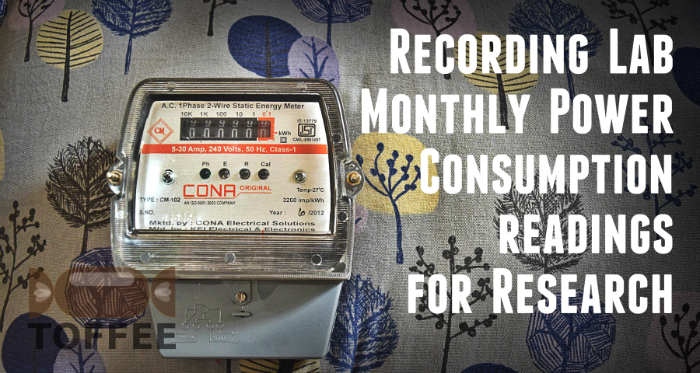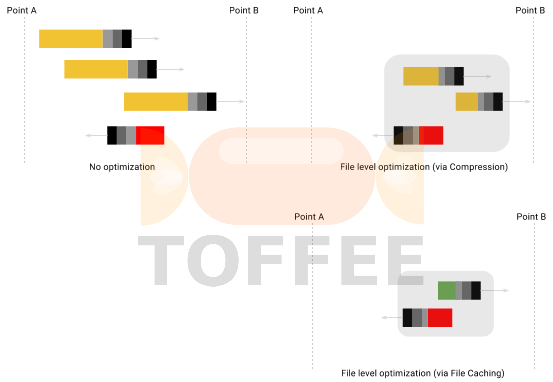RESEARCH 》 Recording Lab Monthly power-consumption readings for Research
Table :: lab_powermeter
| Summary | Days | Meter Reading Start (kWh) | Meter Reading End (kWh) | Consumed Units (kWh) | Avg. Units per day (kWh) | ||
|---|---|---|---|---|---|---|---|
| 933 | 1174.20 | 1.26 | |||||
| Year: 2018 | |||||||
| ID | Month | Days | Meter Reading Start (kWh) | Meter Reading End (kWh) | Consumed Units (kWh) | Avg. Units per day (kWh) | Comments |
| 31 | Dec | 31 | 1132.30 | 1174.20 | 41.90 | 1.35 | * HP Laptop Manjaro Install for Youtube and misc use |
| 30 | Nov | 30 | 1079.60 | 1132.30 | 52.70 | 1.76 | |
| 29 | Oct | 31 | 1032.70 | 1079.60 | 46.90 | 1.51 | * FreeNAS server build. Moving from NETGEAR to FreeNAS |
| 28 | Sep | 30 | 985.90 | 1032.70 | 46.80 | 1.56 | * FreeNAS server build. Moving from NETGEAR to FreeNAS |
| 27 | Aug | 31 | 948.60 | 985.90 | 37.30 | 1.20 | |
| 26 | Jul | 31 | 910.30 | 948.60 | 38.30 | 1.24 | |
| 25 | Jun | 30 | 868.50 | 910.30 | 41.80 | 1.39 | |
| 24 | May | 31 | 829.30 | 868.50 | 39.20 | 1.26 | |
| 23 | Apr | 30 | 794.60 | 829.30 | 34.70 | 1.16 | |
| 22 | Mar | 31 | 760.80 | 794.60 | 33.80 | 1.09 | |
| 21 | Feb | 28 | 730.00 | 760.80 | 30.80 | 1.10 | |
| 20 | Jan | 31 | 704.00 | 730.00 | 26.00 | 0.84 | |
| Summary :: 2018 | 365 | 470.20 | 1.29 | ||||
| Year: 2017 | |||||||
| ID | Month | Days | Meter Reading Start (kWh) | Meter Reading End (kWh) | Consumed Units (kWh) | Avg. Units per day (kWh) | Comments |
| 19 | Dec | 31 | 688.60 | 704.00 | 15.40 | 0.50 | |
| 18 | Nov | 30 | 665.70 | 688.60 | 22.90 | 0.76 | |
| 17 | Oct | 31 | 637.20 | 665.70 | 28.50 | 0.92 | |
| 16 | Sep | 30 | 605.20 | 637.20 | 32.00 | 1.07 | |
| 15 | Aug | 31 | 570.80 | 605.20 | 34.40 | 1.11 | |
| 14 | Jul | 31 | 542.90 | 570.80 | 27.90 | 0.90 | * Lithium-ion battery pack issue fitted with a proper 11.1v compatible charge controller instead of Lead-acid one. * replaced old Samsung LCD Monitor 22'' 2243NWX with new BenQ LED Monitor 24'' GW2470HM (bigger and power-efficient) * replaced old defective Dlink DIR-300 WiFi router with new Xiomi Mi 3C router (faster and power-efficient) |
| 13 | Jun | 30 | 499.90 | 542.90 | 43.00 | 1.43 | * Lithium-ion battery pack issue rectified and serviced so the improved solar output again. |
| 12 | May | 31 | 455.00 | 499.90 | 44.90 | 1.45 | * Lithium-ion battery pack issue and so the degraded solar output for few weeks. |
| 11 | Apr | 30 | 397.50 | 455.00 | 57.50 | 1.92 | * Netgear ReadyNAS rebuilds, GlusterFS, mdadm RAID, FreeNAS ZFS research, etc. |
| 10 | Mar | 31 | 354.80 | 397.50 | 42.70 | 1.38 | |
| 9 | Feb | 28 | 315.20 | 354.80 | 39.60 | 1.41 | |
| 8 | Jan | 31 | 269.40 | 315.20 | 45.80 | 1.48 | |
| Summary :: 2017 | 365 | 434.60 | 1.19 | ||||
| Year: 2016 | |||||||
| ID | Month | Days | Meter Reading Start (kWh) | Meter Reading End (kWh) | Consumed Units (kWh) | Avg. Units per day (kWh) | Comments |
| 7 | Dec | 31 | 228.20 | 269.40 | 41.20 | 1.33 | |
| 6 | Nov | 30 | 185.80 | 228.20 | 42.40 | 1.41 | |
| 5 | Oct | 31 | 148.10 | 185.80 | 37.70 | 1.22 | 1) Using HP Laptop's USB as UPS to power WiFi Router most of the time and charging via Solar power 2) Excess use of Core i7-5820K due to complete migration of all TOFFEE projects on the same |
| 4 | Sep | 30 | 116.10 | 148.10 | 32.00 | 1.07 | 1) Upgrade to 90Watt Solar Panel 2) Excess use of Core i7-5820K for TOFFEE, TOFFEE-DataCenter development, migration of The TOFFEE Project website from Joomla to custom non-Joomla |
| 3 | Aug | 31 | 67.40 | 116.10 | 48.70 | 1.57 | Excess use of Core i7-5820k for TOFFEE-DataCenter development |
| 2 | Jul | 31 | 31.60 | 67.40 | 35.80 | 1.15 | 1) Desktop PC to MiniPC 2) Solar Mini-UPS |
| 1 | Jun | 19 | 0.00 | 31.60 | 31.60 | 1.66 | * initial deployment: 12-Jun-2016 to 30-Jun-2016 |
| Summary :: 2016 | 203 | 269.40 | 1.33 |

Background and Initial Setup: Here is my home lab monthly power-consumption readings for research. This will help to measure and monitor the overall power usage and assess the power requirements. This will help me in future purchases such as UPS, battery upgrades and so on. And as well remove replace old obsolete hardware with new less power-consuming devices. This can be say replacing old monitors with new LED and OLED monitors. Replacing large obsolete PCs with small MiniPC (such as Intel NUC) and Raspberry Pi. Replacing damaged or obsolete 3.5" desktop harddrives with smaller less power efficient 2.5" notebook harddrives and SSD drives and so on.
Analog Kilowatt (KWH) Electricity Meter: To measure the same, I can choose to use either my Kill-a-watt meter or my unused analog dial
based kilowatt meter. In this case I need a device which is much more simple and for more permanent basis. So I chose to use a old type analog
kilowatt meter. I do not have to worry about any data-corruption (which may occur with LED/LCD meter variants). The only disadvantage is that
you cannot reset its old existing meter readings in it. So I chose to open the meter and reset manually to zero by turning the dials before I
install the same for this purpose. Here is my VLOG Youtube video:
Kilowatt Meter Installation: Here is the way I installed the same. I connected directly the ground terminal. And I intercepted the line and
neutral via the Kilowatt Meter. This way I can capture the readings in my kilowatt meter in real-time.

I thought of installing from the start of the month (that is 1-July-2016 00-hours), then again I was quite tempted to install right away on
00-hours 12-Jun-2016 and monitor the same. Anyway since I can find the average units consumed per-day. So I want more data-points I collect before
I upgrade or alter my lab equipment. This way I know how far I am improving the things. As well assess my long term power needs if I ever install any
off-grid power solutions in future. Here is my VLOG Youtube video:
Update 9-Jul-2016: As a research experiment I replaced my Intel Core i7 5820K desktop PC with my Intel Celeron 1037U Mini-PC as my everyday
desktop system. This is an attempt to reduce my overall monthly power consumption. As well an attempt to do feasibility tests and research to know how
far Mini PC will dominate the market in future and to study the real potential of Mini PCs (such as Intel NUC, Intel Compute stick and so on). For few
cases I can still choose to use my high-end desktop such as kernel builds via remote SSH terminal connection, etc. But choose to use Mini-PC as a regular
desktop for all basic workloads. And sometimes for simple software development such as user-space components and GUI modules.
A laptop can be used instead of a Mini-PC, but the laptops in my lab are being used as a dedicated test systems. And sometimes Mini-PC is a better choice
than a laptop, since when you purchase a laptop you need to buy entire package (such as the RAM, Harddrive, inbuilt monitor/screen etc). But a Mini-PC
gives the choice, flexibility and it is modular unlike a laptop. Hence a Mini-PC is cost effective. For more details kindly watch my Youtube VLOG below:
Suggested Topics:
Generic Home Lab Research
| 💎 TOFFEE-MOCHA new bootable ISO: | Download |
| 💎 TOFFEE Data-Center Big picture and Overview: | Download PDF |

Saturday' 13-Mar-2021

Saturday' 13-Mar-2021

Saturday' 13-Mar-2021
Saturday' 13-Mar-2021
Featured Educational Video:

Saturday' 13-Mar-2021
Research :: Optimization of network data (WAN Optimization) at various levels:

Learn Linux Systems Software and Kernel Programming:
![Linux, Kernel, Networking and Systems-Software online classes [CDN] Linux, Kernel, Networking and Systems-Software online classes [CDN]](http://sareesaremypassion.org/cdn/the-toffee-project/i/the_linux_channel_banner2.jpg)
Hardware Compression and Decompression Accelerator Cards:
![TOFFEE Architecture with Compression and Decompression Accelerator Card [CDN] TOFFEE Architecture with Compression and Decompression Accelerator Card [CDN]](http://sareesaremypassion.org/cdn/the-toffee-project/i/DOCUMENTATION/33/TOFFEE%20compression%20hardware.png)
TOFFEE-DataCenter on a Dell Server - Intel Xeon E5645 CPU:





